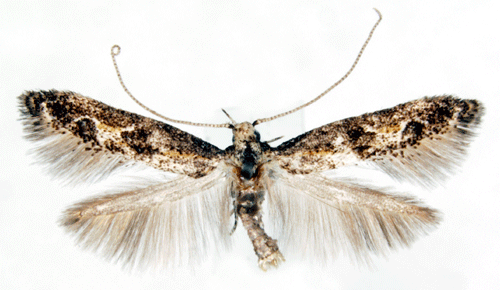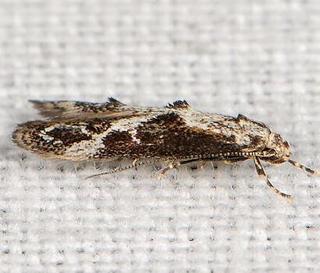Blastodacna
Blastodacna is a genus of butterflies of the family of grass leaf miner ( Elachistidae ).
Features
The head of the moth is beschuppt seamlessly. The sensors are 4/5 as long as the forewings or only slightly shorter than the forewing. The labial palps are stretched. The third segment is bent upwardly, the second segment is significantly thicker at the lower side of projecting large scales. The forewings are lanceolate and have two large tufts protruding scales. The hind wings are only half as wide as the front wings. They are narrowly lanceolate and taper to a point.
In the male the uncus is very small and bumpy. The Gnathos with paired arms is very short and only reaches about half the length of Tegumens. The arms terminate in a hump-shaped appendage which is filled with rows of prongs. The Tegumen is large and long, tapering distally. The Valven are long and narrow, broader in the distal half and extend over the Tegumen addition. The Annellus lobes are large and sclerotized and slightly shorter than the Tegumen. The Vinculum is quite wide and has a short triangular sac. The aedeagus is long and strong and slightly curved in the middle. The vesica is provided with rows of prongs.
In females, the apophyses are roughly equal in length and widened at the top. The ostium is surrounded by a sclerotic genital plate has lateral triangular or band-shaped conical protrusions. The antrum is moderately wide and long and more or less sclerotized. The following is a pear-shaped, wrinkled section with the orifice of the ductus seminalis. The corpus bursae is oval or egg-shaped, is on him either a single Signum in the form of a fuzzy edged invagination or the sign is missing.
Dissemination
The representatives of the genus Blastodacna are located in the Holarctic. Most species are found in the Palearctic.
Biology
The caterpillars live in twigs, plant galls, and the berries of woody rose family ( Rosaceae ). Some species are pests of fruit trees.
System
In Europe, the genus is represented by four species. In Transcaucasia, Asia Minor and the Middle East two types are added. The type species of the genus is Alucita brighter ella.
- Genus Blastodacna Wocke, 1876 Blastodacna atra ( Haworth, 1828)
- Blastodacna brighter ella ( Duponchel, 1838)
- Blastodacna rossica Sinev, 1989
- Blastodacna vinolentella ( Herrich -Schäffer, 1854)
- Blastodacna Georgian ella Sinev, 1988
- Blastodacna libanotica Diakonoff, 1939
From the literature, the following synonyms are known:
- Sintinea Yang, 1977
One can divide the genus Blastodacna into two homogenous groups of species. To the first group belong B. atra, B. brighter ella and B. rossica. It is characterized by the high-contrast drawing on the long narrow forewings, the long, recurved arms of Gnathos with small hump-shaped appendages at the genitals of males and the large, encircling the ostium genital plate at the genitals of the females. The second group includes Georgian ella the species B. and B. vinolentella. In this group, the front wings are colored shorter and wider and more homogeneous. The genitalia of the males the arms of Gnathos are very short, they have big bump like appendages. In females, the genital plate is saddle-shaped reduced. The two groups of species can probably be regarded as subgenera.



.jpg)
.jpg)


.jpg)

.jpg)
